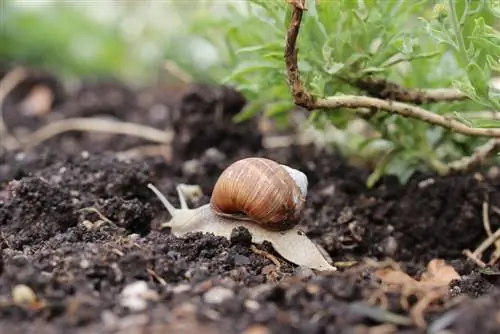- Author admin [email protected].
- Public 2023-12-17 03:39.
- Last modified 2025-01-24 12:45.
When the marten moves into the attic, you usually first notice it through unusual noises and one or two traces of droppings. Martens are predators, they hunt in the wild, and as solitary animals they have their own territories. This gives two clues as to how martens could be caught in a trap: They are attracted by the urine of other martens - and by food.
Hunting prohibited
Martens are furred game and are therefore not allowed to be hunted in Germany. It would therefore be a criminal offense to kill a marten in a trap or otherwise cause it to die. It is not forbidden to drive away the marten or to catch it in a live trap, which is then opened in the wild by an animal expert. This way the marten can find its way back into nature without harming people.
The requirements for marten traps are correspondingly high: the traps must not cause any harm to the animal. They must be designed in such a way that the marten cannot injure itself and that the trap snaps shut without causing the animal any pain. However, martens are very shy animals that move extremely cautiously. This places high demands on the design of the trap, which must only close when the marten is completely inside - otherwise it could suffer injuries. Most marten traps are therefore walk-through traps. They look like a tunnel made of wire and are open at both ends. The locking mechanism is only triggered when the marten is in the middle of the trap, which is at least one meter long, and both doors close at the same time.
Marten traps must be checked twice a day. Because a caught marten panics and suffers mentally. He could hurt himself. For this reason, it is also advisable to only have the trap opened by a specialist. The marten will not sit in the trap, frightened and apathetic, but will react aggressively out of fear if the trap opens. Marten teeth are pointed, the animals have powerful jaws and sharp claws. Although they cannot kill a person, they can cause quite painful damage.
Distributing is not easy
Martens are quite shy and cautious. But once they have found a place to live and marked it with their urine, they do not leave it so easily. You can scare away martens with a lot of shouting, noise and a broom, but in most cases the animal comes back quite quickly. A reasonably warm, wind-protected attic is simply tempting. If a marten has been more or less successfully chased away, all possible access to this undesirable hiding place should be closed. This prevents the animal from moving back in.
Since the smell of urine from a marten always attracts other martens, it is difficult to get an object that has once been obtained from martens free of murder. This also applies to marten infestations in cars - once there's a marten in there, the next one will surely come soon.
Live traps must be baited

Because martens are so shy and cautious, they need a strong incentive to venture into a live trap. A piece of apple is rarely enough. There are special scents available from specialist retailers that attract martens with the urine of other martens or with the scent of ripe fruit. These baits should not only be placed in the wire trap, but should also form a trail leading to the trap from a wider area. If you know where the marten normally moves, you can set the trap as close as possible to or directly on this track. And secondly, scent markings can be placed from these animal trails into the trap. It is ideal if the scent markings start outside the house, for example in a tree that the marten often visits. If the tree is also marked on the top of the branches, the wind ensures that the scent trails spread further.
If you don't want to or can't buy ready-made products from specialist retailers, you can put together your marten's food yourself. In the trap itself, raisins and dried figs, dried tripe and prunes dipped in honey have often proven useful. Fresh tripe is a bad idea because martens have a sensitive nose and tend to reject carrion. The marten will always immediately notice that the rumen offered has not been in the cow for a long time, but is, strictly speaking, carrion.
Now you can of course try to lay a trail to the trap with raisins or figs. It is somewhat doubtful whether the marten actually goes in or eats its fill beforehand. It is more effective to only leave a scent trail outside the trap and offer the food in the trap alone. You can easily mix a scent trail yourself:
- a few egg yolks with
- some anise oil and
- about half a liter of warm water
whisk and apply with a spray bottle in a larger area around the trap. The liquid should be sprayed in such a way that it leaves a trail in the trap and then actually leads to a tasty piece of food.
Skillfully place food in the trap
It doesn't help if the marten just somehow runs into the trap - the trap has to trigger and snap shut. To do this, the bait in the trap must be placed directly on the trigger. The manufacturers describe exactly where it is located in the instructions for use. You should definitely adhere to this information.
Marten traps are available in pet stores, can be purchased over the Internet and can sometimes even be found in auto stores or hardware stores. Animal-friendly traps that are safe, of high quality and do not harm animals are available from around 45 euros. Most traps that are sold cheaper have some defects that are not immediately obvious.
Some martens are foodies

Not all martens like honey plums and raisins. If in doubt, you have to try out what your “own marten” prefers to eat. Some animals really like sweet food, others prefer something heartier. This has proven successful in the past:
- a white raw egg
- Nuts and dried fruit
- a piece of fresh raw meat
- Cat food
If fresh food is used, it should be replaced regularly. Because martens are cautious and prefer to leave a treat lying around. If the meat smells or the egg is no longer quite as fresh, the marten will not be enticed. By the way, some animals also like mixed food: If in doubt, eggs and nuts or meat and cat food can also be combined and placed together on the trigger.
A marten-proof apartment is better than a trap
If you live on the edge of settlements, possibly close to hedges and forests, you should make your car and apartment marten-proof. Because in the long term it becomes annoying to keep catching and releasing the animals. Marten-proof means that vehicles are parked in the garage and it is locked overnight. For houses, this means that neither doors, windows or roof hatches are left open for long periods of time. Barns, garden sheds, arbors and children's playhouses are also sometimes popular hiding places. Martens do not eat holes in walls or dig through the ground into a garden shed. So it's really enough to securely close all entrances.
If the marten was already there, the buildings should be thoroughly cleaned with vinegar water. The vinegar has a very strong smell and can mask the smell of the marten's urine. So the animal won't come back so quickly.






